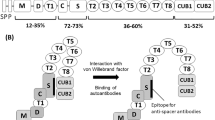Abstract
Background
Thrombotic thrombocytopenic purpura (TTP) is an ultra-rare disorder in childhood and belongs to the microangiopathic hemolytic anemias (MAHA) and the thrombotic microangiopathies (TMA). In the acquired form, autoantibodies against ADAMTS13 inhibit cleaving of von Willebrand factor (vWF) multimers, thereby promoting their interaction with thrombocytes, causing TMA and MAHA. A recently introduced nanobody, caplacizumab, inhibits the binding of platelets to vWF.
Case-diagnosis/treatment
During a first episode, a 10-year-old girl was admitted for TTP. Plasma exchange (PE) and immunosuppressive therapy with corticosteroids and mycophenolate mofetil were initiated. The course was complicated by catheter-associated septicemia and a very slow hematological and clinical recovery. Platelet count became normal at day 40 after admission and treatment initiation. Three years later, the child presented again with TTP. During this second episode, caplacizumab was introduced together with PE and immunosuppressive therapy within 4 days after admission. With this regimen, platelet count normalized within 3 days of treatment, and PE treatment could be stopped after a total of 14 days. The child could be discharged and caplacizumab was continued on an outpatient basis until day 30 after initiation. Adverse events during the use of caplacizumab were not encountered.
Conclusions
Caplacizumab treatment was safe and effective in a child with relapsing, autoantibody-mediated TTP. With respect to this potentially life-threatening condition, the add-on use of caplacizumab represents a novel option to reduce morbidity and mortality and improve quality of life in children and adolescents with TTP.

Similar content being viewed by others
References
Joly BS, Coppo P, Veyradier A (2017) Thrombotic thrombocytopenic purpura. Blood 129:2836–2846
Levy GG, Nichols WC, Lian EC, Foroud T, McClintick JN, McGee BM, Yang AY, Siemieniak DR, Stark KR, Gruppo R, Sarode R, Shurin SB, Chandrasekaran V, Stabler SP, Sabio H, Bouhassira EE, Upshaw JD Jr, Ginsburg D, Tsai HM (2001) Mutations in a member of the ADAMTS gene family cause thrombotic thrombocytopenic purpura. Nature 413:488–494
Scully M, Hunt BJ, Benjamin S, Liesner R, Rose P, Peyvandi F, Cheung B, Machin SJ, British Committee for Standards in Haematology (2012) Guidelines on the diagnosis and management of thrombotic thrombocytopenic purpura and other thrombotic microangiopathies. Br J Haematol 158:323–335
Peyvandi F, Scully M, Kremer Hovinga JA, Cataland S, Knobl P, Wu H, Artoni A, Westwood JP, Mansouri Taleghani M, Jilma B, Callewaert F, Ulrichts H, Duby C, Tersago D, Investigators TITAN (2016) Caplacizumab for acquired thrombotic thrombocytopenic purpura. N Engl J Med 374:511–522
Joly BS, Coppo P, Veyradier A (2018) Pediatric thrombotic thrombocytopenic purpura. Eur J Haematol 101:425–434
Noris M, Remuzzi G (2009) Atypical hemolytic-uremic syndrome. N Engl J Med 361:1676–1687
Furlan M, Robles R, Galbusera M, Remuzzi G, Kyrle PA, Brenner B, Krause M, Scharrer I, Aumann V, Mittler U, Solenthaler M, Lammle B (1998) von Willebrand factor-cleaving protease in thrombotic thrombocytopenic purpura and the hemolytic-uremic syndrome. N Engl J Med 339:1578–1584
Tsai HM, Lian EC (1998) Antibodies to von Willebrand factor-cleaving protease in acute thrombotic thrombocytopenic purpura. N Engl J Med 339:1585–1594
Wieland I, Kentouche K, Jentzsch M, Lothschutz D, Graf N, Sykora KW (2015) Long-term remission of recurrent thrombotic thrombocytopenic purpura (TTP) after rituximab in children and young adults. Pediatr Blood Cancer 62:823–829
Scully M (2012) Rituximab in the treatment of TTP. Hematology 17(Suppl 1):S22–S24
Callewaert F, Roodt J, Ulrichts H, Stohr T, van Rensburg WJ, Lamprecht S, Rossenu S, Priem S, Willems W, Holz JB (2012) Evaluation of efficacy and safety of the anti-VWF nanobody ALX-0681 in a preclinical baboon model of acquired thrombotic thrombocytopenic purpura. Blood 120:3603–3610
Scully M, Cataland SR, Peyvandi F, Coppo P, Knobl P, Kremer Hovinga JA, Metjian A, de la Rubia J, Pavenski K, Callewaert F, Biswas D, De Winter H, Zeldin RK, Investigators HERCULES (2019) Caplacizumab treatment for acquired thrombotic thrombocytopenic purpura. N Engl J Med 380:335–346
Author information
Authors and Affiliations
Corresponding author
Ethics declarations
Conflict of interest
The authors declare that they have no conflict of interest.
Additional information
Publisher’s note
Springer Nature remains neutral with regard to jurisdictional claims in published maps and institutional affiliations.
Rights and permissions
About this article
Cite this article
Kaczmarek, V., Holle, J., Astudillo, R. et al. Caplacizumab for relapsing thrombotic thrombocytopenic purpura. Pediatr Nephrol 34, 1625–1628 (2019). https://doi.org/10.1007/s00467-019-04281-z
Received:
Revised:
Accepted:
Published:
Issue Date:
DOI: https://doi.org/10.1007/s00467-019-04281-z




